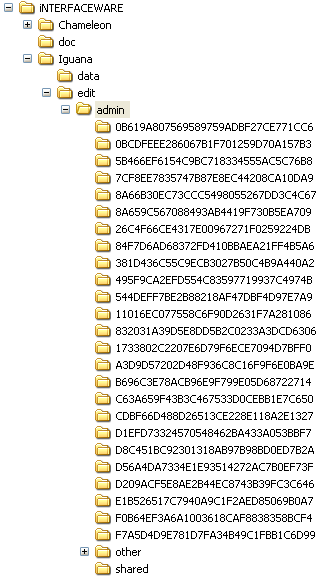Fossil repository layout
Contents
This page explains our fossil repository structure. Normally you should not be editing this code directly unless there are special circumstances.
For instance lets say if Iguana is crashing when you open a script.
Scripts that are being worked on will be checked out into a local ‘sandbox’ on the server hosting Iguana. These will be in a directory ./edit/<user name>/.
Within that directory you’ll see a group of directories with this structure:

The ‘other’ directory contains the vmd files and the shared directory contains common shared modules. Each of the hexadecimal numbers is a globally unique identifier or GUID which represents a Translator instance. The tricky part is to figure out the relationship of GUIDs to channels. For that you need to open up the IguanaConfiguration.xml file which has the GUIDs of the Translator scripts. The locations of the GUIDs depends on the type of Translator script. This table summarizes how to locate them:
iguana_config/channel_config/channel/from_http/@guid
iguana_config/channel_config/channel/from_http/@guid
| Translator Instance Type | Location of GUID (in pseudo XPATH syntax) |
|---|---|
| From Translator | iguana_config/channel_config/channel/from_mapper/@guid |
| To Translator | iguana_config/channel_config/channel/to_mapper/@guid |
| Filter | iguana_config/channel_config/channel/message_filter/@translator_guid |
| Acknowledgment | iguana_config/channel_config/channel/from_llp_listener/@ack_script |
| From HTTP | iguana_config/channel_config/channel/from_http/@guid |
The tag names are a little inconsistent reflecting the original internal name of the Translator, imaginatively called “mapper” in it’s early days.
